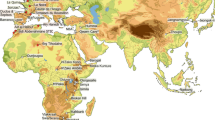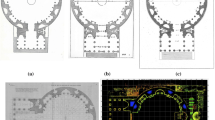Abstract
This paper describes the formal representation and analysis of a visual structure –craquelure (an accidental feature of paintings).Various statistical methods demonstrate a relationship between a formal representation of craquelure and art-historical categories of paintings. The results of this work provide confirmation of connoisseurial claims regarding craquelure as a broad indicator of authorship. The techniques employed in this study are; repertory grid, hierarchical clustering, multidimensional scaling and discriminant analysis.
Similar content being viewed by others
References
Bucklow, S.L. “The Description of Craquelure.” Studies in Conservation, 42 (1997), 129–140.
Burrows, J.F. Computation into Criticism. Oxford: Clarendon Press, 1987.
Campbell, L. “The Art Market in the Southern Netherlands in the Fifteenth Century.” Burlington Magazine, 118, 877 (1976), 188–197.
Everitt, B.S. Cluster Analysis. London: Edward Arnold, 1993.
Fleming, S.J. Authenticity in Art: The Scientific Examination of Forgery, Institute of Physics. London, 1975.
Fransella, F. and D. Bannister. A Manual for Repertory Grid Technique. London: Academic Press, 1977.
Friedländer, M.J. On Art and Connoisseurship. Transl. T. Borenius. London: Bruno Cassirer, 1942.
Goffen, R. Giovanni Bellini. New Haven: Yale University Press, 1989.
Ichoku, C. and J. Chorowicz. “A Numerical Approach to the Analysis and Classification of Channel Network Patterns.” Water Resources Research, 30 (1994), 161–174.
Kelly, G.A. The Psychology of Personal Constructs. New York: Norton, 1955.
Kruskal, J.B. “The Relationship between Multidimensional Scaling and Clustering.” In Classification and Clustering. Ed. J. van Ryzin. New York: Academic Press, 1977, pp. 17–44.
Latta, G.F. and K. Swigger. “Validation of the Repertory Grid for use in Modeling Knowledge.” Journal for the American Society for Information Science, 43(2) (1992), 115–129.
Laurie, A.P. “Crackle and Forgeries of Primitives.” The Connoisseur, 81 (1928), 157–161.
Mecklenburg, M.F., M. McCormick-Goodhart and C.S. Tumosa. “Investigation into the Deterioration of Paintings and Photographs Using Computerised Modelling of Stress Development.” Journal of the American Institute for Conservation, 33 (1994), 153–107.
Morelli, G. Italian Painters: Critical Studies of Their Works, 2 Vols. Transl. C.J. Ffloulkes. London, 1892/3.
Ore, E.S. “Teaching New Tricks to an Old Map.” Computers and the Humanities, 28 (1995), 283–289.
Renders, E. “Cracks in Flemish Primitives.” Burlington Magazine, LII(CCXCIX) (1928), 59–65.
Serra, J. Image Analysis and Mathematical Morphology. London: Academic Press, 1982.
Shaw, M.L.G., Ed. Recent Advances in Personal Construct Theory. London: Academic Press, 1981.
Storm van Leeuwen, J. “The Concept of Pictology and Its Application to Works by Frans Hals.” Authentication in the Visual Arts. Ed. H.L.C. Jaffé. Amsterdam: B. M. Israel, BV, 1979.
Stout, G.L. “A Trial Index of Laminal Disruption.” Journal of the American Institute for Conservation, 17 (1977), 17–26.
van Dantzig, M.M. Pictology. Leiden: E. J. Brill, 1973.
Walden, S. The Ravished Image. London: Weidenfeld and Nicholson, 1985.
Wölfflin, H. Principles of Art History, dy1915. Transl. M.D. Hottinger. New York: Dover, 1950.
Woolheim, R. On Art and the Mind. London: Allen Lane, 1977.
Wright, J. “Antonello da Messina, The Origins of His Style and Technique.” Art History, 3(1) (1980), 41–60.
Author information
Authors and Affiliations
Rights and permissions
About this article
Cite this article
Bucklow, S.L. A Stylometric Analysis of Craquelure. Computers and the Humanities 31, 503–521 (1997). https://doi.org/10.1023/A:1001031931132
Issue Date:
DOI: https://doi.org/10.1023/A:1001031931132




